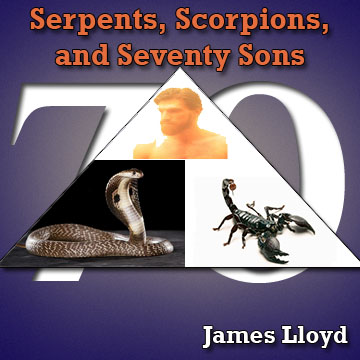|
Christian
Media
Communiqué
The Great Exchange
Part XLIV

As we've approached the subject of the mystical descriptions of the divided mind of the Devil, we're also seeing some very subtle clues about how the Spirit of Antichrist has come to permeate this entire world.
Those who have walked with the LORD for some time have learned that God regularly provides His sons and daughters with communications and signs, which others consider to be frivolous, or even the result of superstitious excess.
"The natural man receiveth not the things of the Spirit of God: for they are foolishness unto him: neither can he know them, because they are spiritually discerned" (I Corinthians 2:14).
An interesting example of this type of communication is found in the Scriptural phrase referring to "they that dwell on the earth."
We have previously noted those who "dwell on the earth" is consistently applied as a metaphoric phrase referencing the earth dwellers as the lost. It is contrasted with the saved, who are identified as "them that dwell in heaven" (Revelation 13:6).
While believers have been conditioned to conclude that we will only dwell in heaven after we die, the Scriptures actually teach that our life in Christ, which is obviously in the venue of the Spirit, begins when we are born again in Him. Thus, as we are presently seated "in heavenly places in Christ" (Ephesians 1:3), we are told to rejoice as the Son of God has overcome the dragon's despicable plan, as the Devil has been cast down and exiled on the earth – where the lost "dwell."
"Rejoice, ye heavens, and ye that dwell in them. Woe to the inhabitors of the earth and of the sea! For the devil is come down unto you, having great wrath, because he knoweth that he hath but a short time" (Revelation 12:12).
The phrases concerning those who dwell on the earth are usually paired with some action, which serves as the initialization of why they dwell on the earth. For instance, the Spirit in the second beast (the False Prophet) is the one that "deceiveth them that dwell on the earth" (Revelation 13:14), and this earth bound restriction occurs because of the Deception, which leads to the embrace of the Spirit in the first beast (imaged as Antichrist, or Death).
"And the great dragon was cast out, that old serpent, called the Devil, and Satan, which deceiveth the whole world: he was cast out into the earth, and his angels were cast out with him" (Revelation 12:9).
This is why Jesus made statements that sounded odd at the time, such as when He was calling disciples, and one asked him if he could wait until he had buried his father.
"And another of his disciples said unto him, Lord, suffer me first to go and bury my father. But Jesus said unto him, Follow me; and let the dead bury their dead" (Mathew 8:21, 22).
We fail to see the whole world is already Spiritually dead, even though the shadow that is this world appears to be alive. Thus, the LORD was saying the Spiritually dead can bury the physically dead, but the disciple that He called – allegorically seen as any person that Christ has called to salvation – should immediately follow Him.
Indeed, the very next verse in this sequence elaborates on this, as another said he would follow the LORD, but he first wanted to say goodbye to those dwelling in his house.
"And another also said, Lord, I will follow thee; but let me first go bid them farewell, which are at home at my house. And Jesus said unto him, No man, having put his hand to the plough, and looking back is fit for the kingdom of God" (Luke 9:61,62).
This is, by the way, a Sequential Recapitulation of the Israelites who wanted to go back to Egypt, when the LORD had called them to be His chosen.
"And they said one to another, Let us make a captain, and let us return into Egypt" (Numbers 14:4).
A subtle thread of communication is found in the phrase "them that dwell on the earth" (and other variant phrases) as a similitude of those whose life is only in the finite world of physical existence. Not only is it sharply contrasted with "them that dwell in heaven" (Revelation 13:6), but we also see verses where the LORD dwells in His temple – which is the present day body of the believer.
The point is, the Spirit of the LORD dwells in the believer, and the believer is in Christ, who is seated at the right hand of the Father – NOW.
"Ye are not in the flesh, but in the Spirit, if so be that the Spirit of God dwell in you" (Romans 8:9).
Unfortunately, the body of Christ is now deeply immersed in the long prophesied Falling Away from the Spiritual reality of our present existence in the "heavenly places."
In our generation, Christians have been conned into believing in a literal, physical series of events, that has persuaded them they will be saved if they make the right decisions as these events come to pass. As significant events which they've been prophetically programmed to expect come to pass, their faith in the faulty physical pattern is strengthened, and this diminishes their Spiritual discernment.
Believers are expecting a physical Antichrist that they hope to resist. Whether they have been convinced they will never see this fictional figure through the enormous lie that is the pre-tribulation Rapture, or they believe they will endure the horrors of the anticipated tribulation (standing side by side with the physical Jewish people they've been taught are the real chosen of the LORD), is academic.
This massive deception is vividly described in the Scriptures, and it is directly linked to the Image of the Beast passages in Revelation. As stated in last week's installment of The Great Exchange, the Image of the Beast is the body inhabited by the Spirit of Antichrist, and "all that dwell upon the earth shall worship him" (Revelation 13:8).
The False Prophet imagery tells us this Spirit has the power to energize ("give life" in the text) the body of the beast.
"And he had power to give life unto the image of the beast, that the image of the beast should both speak, and cause that as many as would not worship the image of the beast should be killed" (Revelation 13:15).
Few are aware the word for life in this section of Revelation is not the same word translated life in most of the other Scriptures. For example, in John 3:16, when Jesus said the famous passage "For God so loved the world, that he gave his only begotten Son, that whosoever believeth in him should not perish, but have Everlasting Life," he used a different Greek word for life than the "life" the False Prophet gives to the Image.
The Greek manuscripts tell us Christ used the word Zoe, which occurs all over the New Testament – mostly referencing the eternal life given to us by the LORD. Another word, Psyche, also occurs, referring to physical life – such as "Whosoever shall seek to save his [earthly] life shall lose it" (Luke 17:33).
The "life" that is given to the Image of the Beast is Pneuma (where we get our word pneumatic, indicating an automatic process), and it's uniquely applied to this very unusual power seen in the Image of the Beast. To put it another way, Revelation is telling us that Satan is able to infuse a Spiritual power in this body of the beast, and those who "dwell on the earth" believe it is life, when it is actually a lie.
"For this cause God shall send them strong delusion, that they should believe a lie" (II Thessalonians 2:11).
The ominous fact in this context is that Pneuma is not used to describe those who adhere to overtly false religion (such as Islam, Hinduism, or even Satanism). It is applied to anyone who does not avail themselves of the life of the LORD by being born again in JESUS CHRIST, and coming to union with the living God.
In other words, Death is the default position for "them that dwell on the earth" (Revelation 14:6).
This accentuates the sharp contrast with those "that dwell in Him" (I John 4:13).
"Ye are the temple of the living God; as God hath said, I will dwell in them, and walk in them" (II Corinthians 6:16).
An adjacent series of verses helps to shed further light on the counterfeit life which is used to animate the collective that is actually the body of Antichrist. The Pneuma "life," which we've already likened to the Spirit of Hell that delivers his prey to the Spirit of Death, is manifested when he "deceiveth them that dwell on the earth" into refusing the Life of Christ – which is synonymous with embracing the Death in Antichrist.
"And all the world wondered after beast" (Revelation 13:3).
The word wonder is the Greek word existemi – where we get our word ecstasy or ecstatic.
When we review an English dictionary, we find the following:
"Ecstasy: A feeling or state of intense, often extreme, mental and emotional exaltation. To fill with ecstasy or rapture" (Webster's Third New International Dictionary, emphasis mine).
The inclusion of the word rapture is simply another sign from the LORD that the doctrine which the Scriptures so conclusively reject is related to the deception emanating out of the False Prophet.
It is not a coincidence the dictionary includes the word exaltation in its linkage to the ecstatic response to the beast. The Holy Bible also uses this word when describing the Satanic power.
"The son of perdition…exalteth himself…so that he as God sitteth in the temple of God" (II Thessalonians 2:4).
It should be noted that when "those who dwell on the earth" are beguiled (Genesis 3:13) when they behold the beast, as they "wonder," every aspect of this is tied to the "two parts" which are flesh and blood -- as opposed to the Spiritual "third part" defined by the prophet Zechariah.
"In all the land, saith the Lord, two parts therein shall be cut off and die; but the third shall be left therein."
"And I will bring the third part through the fire, and will refine them as silver is refined, and will try them as gold is tried: they shall call on my name, and I will hear them; I will say it is my people: and they shall say, The Lord is my God" (Zechariah 13:8, 9).
In last week's installment of The Great Exchange, we addressed the earth bound properties of the human brain, and how trillions of neurons form pathways that host our thought processes. We also covered how these synaptic circuits have periodic gaps which are briefly connected through a chemical called Dopamine, which is created by the body.
When the dopamine completes the circuit, a physical, earthly connection is completed which is pleasurable. This process is extremely sophisticated, and is tied to the earthly environment, which provides our minds with input.
Thus, the existemi that animates the flesh and blood side of our existence, is directly related to the Pneuma, or flesh and blood "life" which is imparted to the Image of the Beast through the deception generated by the False Prophet.
As the LORD seeks to instill His divine Life through His amazing Spirit, we find an absolutely stunning reference to the flesh and blood controlled synaptic gap of mankind, in the Old Testament.
"And I sought for a man among them, that should make up the hedge, and stand in the gap before me for the land, that I should not destroy it: but I found none" (Ezekiel 22:30).
"And I looked, and there was none to help; and I wondered that there was none to uphold: therefore mine own arm brought salvation unto me…" (Isaiah 63:5).
"For God so loved the world, that He gave His only begotten Son, that whosoever believeth in him should not perish, but have everlasting life" (John 3:16)
-- James Lloyd
To Be Continued
____________________________
|

Great and Marvelous

Stealth Dispensationalism

Gene Autry-Doja Cat

The Baal Bible

The Revolutionary Role Reversal

Ten Kings

Image Of The Beast

Something

Deadly Wound

You're In The Army Now

The Remnant Of Israel

Kingdom Within You

Jesus IS

New Heart From Heaven

Rivers Of Babylon

One Night Town

Centuries

Whore Of Babylon

Crazy

Get Away

Turn Up The Radio

I Hear You Knocking

Circle Of Friends
|
|
Click here to make CMTV your
homepage
Christian Media Network Catalog
Also from James Lloyd
|

The Baal Bible DVD
James Lloyd summarizes the role of the heathen "scriptures" from Mesopotamia, which the scholars are using to leaven the genuine Word of God. In what he has dubbed the "Baal Bible," these Gentile writings speak of the Creation, the Garden episode, and the Great Flood, even as they glorify Baal. Part of a much larger conspiracy, since these Satanic records provide a distorted version of Genesis, the faulty dating of the scholars has conned Christian leaders into telling us the Baal Bible is the original, and the Hebrew Scriptures are the copy!
Details Here!

Escape From Planet Egypt
This new book is the electrifying story of how the Spirit of Antichrist has deceived the scholars into believing the Occult material from ancient Gentile writings generated the growing belief in the Divine Council heresy. James Lloyd's earlier book, Dead Men's Bones, provided a Scriptural refutation of the doctrine that claims the LORD directs a "council" of lesser gods, fallen angels, and heavenly beings.
Details Here!

Thou Shalt Ascend:
The Storm Of Gog and Magog
Thou Shalt Ascend details the amazing reality of how the devils came to battle JESUS CHRIST at the entrance of the kingdom of God. In the new Christian Media DVD, Thou Shalt Ascend: The Storm Of Gog and Magog, James Lloyd shows how the fabled Gog and Magog Prophecies show a deeper Spiritual layer of the military conflict at the end of the age, as they actually describe the war in heaven (Revelation 12:7), when the dragon (and his Angelic Rebel Coalition) is cast out of heaven.
Details Here!

The 5th Dynasty
Related to the concept of Twin Timelines in which sequential episodes occur more than once in Scripture and History, this DVD looks at the rebellions against Moses in the Wilderness. Recognizing the failed revolt in Numbers 16, in which Korah and his followers died trying to overthrow Moses, the same thing occurred in 1649 AD as a parallel Christian rebellion tried to seize the throne of England for Christ. Known as the 5th Monarchy, James Lloyd connects this historical event with the 5th Dynasty of Israel, led by Jehu in I Kings 19:16.
Details Here!

Serpents, Scorpions, And Seventy Sons
Another new DVD from James Lloyd, Serpents, Scorpions, and Seventy Sons is 2 hours of dynamite video, derived from the TV program The Apocalypse Chronicles. Using the Scriptural record, James shows how the number 70 was related to the LORD's election of Israel, as
His mediator to the Gentiles. The number is based on the presence of the children of Israel in Egypt, and this study shows how it symbolizes God's redemptive process, as Israel was chosen as "a light to the Gentiles"
(Isaiah 49:6).
Details Here!

The Saga Of Esau
Distilling Esau's behavioural patterns down to two themes related to how he despised the will of the LORD, and assigned blame to innocents whom he purposed to kill, James shows how The Saga of Esau is echoed in the Edomites, King Herod, the religious council of the Jewish leadership which rejected Christ, and even Antichrist and the False Prophet.
Details Here!

Twin Timelines DVD
Tying the various events of the presidential campaign (and the first 9 months of the Trump presidency) to what we call the Prophetic Parallels, this amazing new DVD features James detailing the entire cycle of the Twin Timelines – including predictions of where we go from here.
Details Here!

Dead Men's Bones DVD
A 2 hour DVD in which James Lloyd refutes the false doctrine of the Divine Council Paradigm. Spreading like wildfire, prophecy teachers are claiming God turned over the Gentiles (at the Tower of Babel) to a "council" of angels and the false "gods" of the Gentiles. The heresy is based on heathen manuscripts praising Baal and, incredibly, many Christian scholars are claiming certain Old Testament verses were derived from writings dedicated to Baal!
Details Here!

Traversing The Triuniverse
Traversing The Triuniverse is a unique new studio audio narrative from James Lloyd. Based on the article of the same name, James reviews the twin timelines concept, which has been previously examined, wherein the New Testament events parallel the Old Testament sequences. Now, in Traversing The Triuniverse, he takes the prophetic parallels a step further, showing how the Spiritual fulfillment is the substance, but the physical timeline, inhabited by the Spirit of Antichrist, which is the shadow, takes the same sequence, and reverses the roles.
Video Here!

Lord, Lord
Those famous words, familiar to Christians reading the New Testament, are spoken at the time of judgment, when the Bible says MANY will be turned away. Most believers are also aware of the ominous response in which Christ tells this "many" to depart from Him, as He never knew them.
Details Here!

A Light To The Nations - Book
This book includes the astonishing prophetic metaphor where Jonah, symbolizing Old Covenant Israel, resists the call to prophesy to the Gentiles, and sails to Europe to escape the LORD's will. Swallowed up in symbolic Death – and then deposited back onto the land, where the Christ rejecting state re-emerges in 1948 as an involuntary witness, Jonah is an important figure in prophecy. Meanwhile, true Spiritual Israel is seen passing through the sea, walking in the will of the LORD, at the Exodus, even as the earthdwellers (the Egyptian host in the text) are destroyed.
Details Here!

The Rise And Fall Of The Romerican Empire - Book
In this amazing book, James brings together all the components of prophecy, including the Prophetic Parallels, the 6, 7, 8 Cycle, the Beast That Was sequence, the Little Horn, and the Twin Timelines of Bible Prophecy. Integrating these modularized phenomena into a seamless whole, The Rise and Fall Of The Romerican Empire deciphers Bible Prophecy in an unprecedented fashion.
The identity of Antichrist is again revealed in this work, as well as clearly showing where we are now in the prophesied sequence of events. His largest book in 20 years, the Rise and Fall Of The Romerican Empire is the definitive work which systematically presents the truth of Remnant theology.
Details Here!

The Collective - Book
This book details how the Spiritual entity is essentially the opposite of the body of Christ. Symbolically articulated in the book of Revelation as the Image of the Beast, the Spiritual formation could also be described as the body of Antichrist. This polarity places the body of Christ on one end of the Spiritual spectrum, and the body of Antichrist on the other.
Details Here!

The Culting Of Christianity - Book
The Culting Of Christianity links Egyptian mysticism to leaders in the early church, as well as Jewish opponents of Christianity.
An incendiary breakthrough, James conclusively shows the idea of a pre-tribulational evacuation was written in religious documents before Jesus was born. And it doesn't stop there, as James tracks how Occultic writings influenced the development of early Christian doctrine.
Details Here!

The Counterfeit Antichrist
The first new DVD from James Lloyd in several years, this 2 hour TV program examines the rapidly growing idea the appearance of "the" Antichrist will be tied to the prophesied Moslem saviour figure known as The Mahdi.
Many Christian preachers and prophecy authors are now embracing a variation on the ancient "revived Roman Empire" lie with a scenario in which the end times "Antichrist" arrives as a powerful leader from the Islamic world. Leaning on Islamic prophecy itself, in the process of presenting their case in books, television programs, and speaking engagements, these false prophets are pitching another gospel (II Corinthians 11:4) which fails to recognize the truth about the Spiritual entities – commonly identified as Antichrist and The False Prophet -- found in Revelation.
Video Here!
|
The Christian Media Ministry makes our materials available through gifts made to the ministry. When you help Christian Media, we reciprocate with the materials in which you've indicated an interest. Supporters of our ministry do so because they believe in the message the LORD has given us, and we seek to follow the Spiritual directive which Christ gave to the Apostle Peter, in that we seek to feed His sheep. This constitutes a contract, in that gifts we receive indicate a willingness to be instructed in the things of the LORD, as the supporting gifts we receive from the body of Christ allow us to continue in the mission He has called us to.
Help row the CMN boat
Click on the oar
to donate with Paypal
Online CM Fellowship
For Remnant Believers
To join
send an email to
JamesLloyd@mediachristianman.com
Volunteer Programs
- If you'd like to serve the cause of Christ, we have
Internet volunteer programs in place - just email James Lloyd at
the above address
|

















